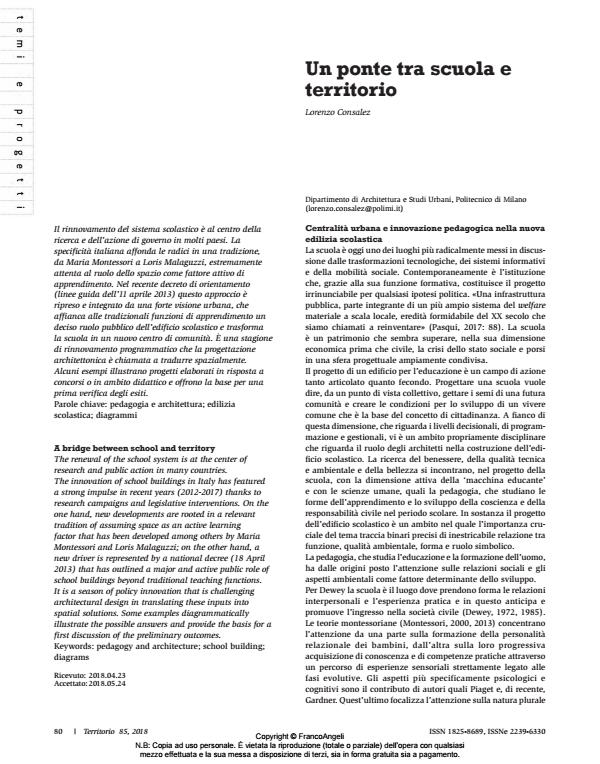A bridge between school and territory
Journal title TERRITORIO
Author/s Lorenzo Consalez
Publishing Year 2018 Issue 2018/85
Language Italian Pages 13 P. 80-92 File size 3899 KB
DOI 10.3280/TR2018-085010
DOI is like a bar code for intellectual property: to have more infomation
click here
Below, you can see the article first page
If you want to buy this article in PDF format, you can do it, following the instructions to buy download credits

FrancoAngeli is member of Publishers International Linking Association, Inc (PILA), a not-for-profit association which run the CrossRef service enabling links to and from online scholarly content.
The renewal of the school system is at the center of research and public action in many countries. The innovation of school buildings in Italy has featured a strong impulse in recent years (2012-2017) thanks to research campaigns and legislative interventions. On the one hand, new developments are rooted in a relevant tradition of assuming space as an active learning factor that has been developed among others by Maria Montessori and Loris Malaguzzi; on the other hand, a new driver is represented by a national decree (18 April 2013) that has outlined a major and active public role of school buildings beyond traditional teaching functions. It is a season of policy innovation that is challenging architectural design in translating these inputs into spatial solutions. Some examples diagrammatically illustrate the possible answers and provide the basis for a first discussion of the preliminary outcomes.
Keywords: Pedagogy and architecture; school building; diagrams
- Armando A., Durbiano G., 2017, Teoria del progetto architettonico. Dai disegni agli effetti. Roma: Carocci.
- Biondi G., Borri S., Tosi L., 2016, a cura di, Dall’aula all’ambiente di apprendimento. Firenze: Altralinea Edizioni.
- Bagnara S., Campione V., Mosa E., Pozzi S., Tosi L., 2014, Apprendere in digitale. Come cambia la scuola in Italia e in Europa. Milano: Guerini e Associati.
- Borri S., 2016, a cura di, Spazi educativi e architetture scolastiche: linee e indirizzi internazionali. Firenze: indire.
- Cannella G., 2015, «Lo spazio informale: dalle Linee guida per l’edilizia scolastica alla realizzazione pratica». Turris Babel, 97, Bolzano: Fondazione Architettura Alto Adige, 42-44.
- Ceppi G., Zini M., 1998, a cura di, Bambini, spazi, relazioni metaprogetto di ambiente per l’infanzia. Reggio Emilia: Reggio Children-Domus Academy Research Centre.
- Dewey J., 1972, Democrazia e educazione. Firenze: La Nuova Italia.
- Dewey J., 1985, Scuola e società. La Nuova Italia: Firenze.
- Fianchini M., 2017, a cura di, Rinnovare le scuole dall’interno. Scenari e strategie di miglioramento per le infrastrutture scolastiche. Sanatarcangelo di Romagna, Rimini: Maggioli.
- Frabboni F., Borghi B.Q., 2017, Loris Malaguzzi e la scuola a nuovo indirizzo. Bergamo: Zeroseiup.
- Gardner H., 1987, Formae Mentis. Saggio sulla pluralità dell’intelligenza. Milano: Feltrinelli.
- Gardner H., 1994, Intelligenze creative. Milano: Feltrinelli.
- Hertzberger H., 2008, Space and Learning. Rotterdam: 010 Publisher.
- Lippmann P., 2010, Evidence-based design of elementary and secondary school: a responsive approach to creating learning environments. New Jersey: Wiley.
- Malaguzzi L., 1995, In viaggio con i diritti delle bambine e dei bambini. Reggio Emilia: Reggio Children.
- Montessori M., 2000, L’autoeducazione. Milano: Garzanti (I ed. 1916).
- Montessori M., 2013, La scoperta del bambino. Milano: Garzanti.
- Mosa E., 2016, «Principali direttrici di ricerca internazionali sul rapporto tra didattica e spazi educativi». In: Borri, 2016, 13-27.
- Pasqui G., 2017, «Buone pratiche in classe». Abitare, 570: 86-95.
- Pezzetti L.A., 2012, Architetture per la scuola. Impianto, forma, idea. Napoli: Clean.
- Piaget J., Inhelder B., 1976, La rappresentazione dello spazio nel bambino. Firenze: Giunti e Barbera.
- Tagliabue L.C., Consalez L., Mastrolembo Ventura S., Ciribini A.L., 2016, «The Educational Building in the Circular Economy: an Extended Concept of Asset Quality». In: Ciribini A., Alaimo G., Capone P., Daniotti
- B., Dell’Osso G., Nicolella M., a cura di, BACK TO 4.0: Rethinking the Digital Construction Industry. Santarcangelo di Romagna, Rimini: Maggioli, 331-340.
- Tosi L., 2016, «Spazi educativi flessibili e ambienti differenziati». In: Borri, 2016, 45-87.
- Weyland B., Attia S., 2015, Progettare scuole: tra pedagogia e architettura. Milano: Guerini.
- Cultural Heritage Education in the Everyday Landscape Bertrando Bonfantini, pp.11 (ISBN:978-3-031-10394-0)
- Back to (the Future) School. Reshaping the Relationship Between Mobility and Schools Fabrizia Cannella, Samuel Fattorelli, Maria Chiara Tosi, Valentina Rossella Zucca, in Cahiers de la recherche architecturale, urbaine et paysagère /2022
DOI: 10.4000/craup.11501 - Le scuole tra piani, burocrazie e modelli. Il caso milanese Cristina Renzoni, Paola Savoldi, in TERRITORIO 90/2020 pp.50
DOI: 10.3280/TR2019-090006
Lorenzo Consalez, Un ponte tra scuola e territorio in "TERRITORIO" 85/2018, pp 80-92, DOI: 10.3280/TR2018-085010